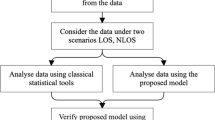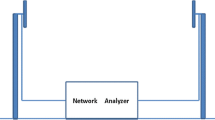Abstract
This paper presents minimal-ray a sum-of-sinusoids fading model with one direct signal and multipath signal as minimum as three in number, having phase, attenuation, and time of arrival as random variables for random scatterer area. In most of the literature, fading simulators assume independence of random phase and angle of arrival. Because of this, at the receiver side, the demodulator has to adjust the phase by trial and error method to recover the original time-variant signal which is a tedious process. If the dependency of the random phase and the angle of deviation is proved, then it is easier at the receiver side for the demodulator to adjust the phase directly. This work defines the simple relationship between the angle of deviation and random phase which can directly help at the receiver side for adjusting the deviation occurred in the transmitted signal. The statistical characteristics of the proposed model are analyzed and validity is ensured with empirical data for the Worldwide interoperability for microwave access (Wi-MAX) application. The goodness of fit is verified with the Kolmogorov–Smirnov test and the results show that it agrees best with the Ricean distribution, compared with Rayleigh distribution.









Similar content being viewed by others
References
Arrendondo, J., Chriss, W., & Walker, E. (1973). Multipath fading simulator for mobile radio. IEEE Transactions on Vehicular Technology, 23(11), 1325–1328.
Romero-jerez, J., Lopez-Martinez, F., Paris, J., & Goldsmith, A. (2017). The fluctuating two-Ray fading model: Statistical characterization and performance analysis. IEEE Transactions on Wireless Communications, 6(7), 4420–4432.
Patzold, M., Killat, U., Laue, F., & Li, Y. (1996). A deterministic method for the derivation of a discrete WSSUS multipath fading channel model. European Transactions on Telecommunications and Related Technologies, 7(2), 165–175.
Casas, E., & Leung, C. (1998). A simple digital fading simulator for mobile radio. In Proceedings of IEEE vehicular technology conference (pp. 212–217).
Zhen, Y., & Xiao, C. (2002). Improved model for the generation of multiple uncorrelated Rayleigh fading waveforms. IEEE Communications Letters, 6(6), 256–258.
Alimohammad, A., Fard, S., Cockburn, B., & Schlegel, C. (2009). Compact Rayleigh and Rician Fading simulator based on random walk processes. IET Communications, 3(8), 1333–1342.
Young, D. J., & Beaulieu, N. C. (2000). The generation of correlated Rayleigh random variates by inverse Fourier transform. IEEE Transactions on Communications, 48(7), 1114–1127.
Patzold, M. (2011). Mobile fading channels (2nd ed.). Chichester: Wiley.
Zhen, Y., & Xiao, C. (2002). Improved model for the generation of multiple uncorrelated Rayleigh fading waveforms. IEEE Communications Letters, 6(6), 256–258.
Clarke, R. (1968). A statistical theory of mobile-radio reception. Bell System Technical Journal, 47(6), 975–1000.
Xiao, C., Zheng, Y., & Beaulieu, N. (2003). Statistical simulation models for Rayleigh and Ricean fading. In Proceedings of IEEE international conference on communications, Anchorage, AK, USA (pp. 3524–3529).
Baddour, K., & Beaulieu, N. (2005). Autoregressive modeling for fading channel simulation. IEEE Transactions on Wireless Communications, 04(04), 1650–1662.
Jakes, W. (1994). Microwave mobile communications. Piscataway, NJ: Wiley-IEEE Press.
Patel, C., Stber, G. L., & Thomas, G. P. (2005). Comparative analysis of statistical models for the simulation of Rayleigh faded cellular channels. IEEE Transactions on Communications, 53(6), 1017–1026.
Pop, M., & Beaulieu, N. (2002). Design of wide-sense stationary sum-of-sinusoids fading channel simulators. In Proceedings of IEEE international conference on Communications, New York, NY, USA (pp. 709–716).
Pop, M., & Beaulieu, N. (2001). Limitations of sum-of-sinusoids fading channel simulators. IEEE Transactions on Communications, 49(4), 699–708.
Borhani, A., & Ptzold, M. (2013). A unified disk scattering model and its angle-of-departure and time-of-arrival statistics. IEEE Transactions on Vehicular Technology, 62(2), 473–485.
Chen, Y., & Dubey, V. (2004). Accuracy of geometric channel-modeling methods. IEEE Transactions on Vehicular Technology, 53(1), 82–93.
Liberti, J., & Rappaport, T. (1996). A geometrically based model for line-of-sight multipath radio channels. In Proceedings of IEEE vehicular technology conference, Atlanta, GA, USA (pp. 844–848).
Ertel, R., & Reed, J. (1999). Angle and time of arrival statistics for circular and elliptical scattering models. IEEE Journal on Selected Areas in Communications, 17(11), 1829–1840.
Petrus, P., Reed, J., & Rappaport, T. (2002). Geometrical-based statistical macrocell channel model for mobile environments. IEEE Transactions on Communications, 50(3), 495–502.
Borhani, A., & Ptzold, M. (2014). A novel non-stationary channel model utilizing Brownian random paths. REV Journal on Electronics and Communications, 4(1–2), 8–15.
Borhani, A., & Ptzold, M. (2015). A highly flexible trajectory model based on the primitives of Brownian fields—Part I: Fundamental principles and implementation aspects. IEEE Transactions on Wireless Communications, 14(2), 770–780.
Borhani, A., & Ptzold, M. (2016). A highly flexible trajectory model based on the primitives of Brownian fields—Part II: Analysis of the statistical properties. IEEE Transactions on Wireless Communications, 15(1), 247–257.
Borhani, A., Stber, G. L., & Ptzold, M. (2017). A random trajectory approach for the development of nonstationary channel models capturing different scales of fading. IEEE Transactions on Vehicular Technology, 66(1), 1–13.
Borhani, A., & Ptzold, M. (2016). A non-WSSUS mobile-to-mobile channel model assuming velocity variations of the mobile stations. IEEE Transactions on Wireless Communications, 15(1), 247–257.
Gutierrez, C., Patzold, M., Dahechand, W., & Youssef, N. (2017). A non-stationary mobile-to-mobile multipath fading channel taking account of velocity variations of the mobile stations. In Proceedings of IEEE wireless communications and networking conference, San Francisco, CA, USA (pp. 1–6).
Rorabaugh, C. B. (2004). Simulating wireless communication system: Practical models in C++. London: Prentice Hall.
Bhise, S., & Khot, U. (2019). Random phase and time of arrival statistics for circular disk scattering model. Springer Wireless Networks, 25(6), 3579–3585.
McClaning, K. (2011). Wireless receiver design for digital communications (2nd ed.). Raleigh, NC: SciTech Publishing.
Pedersen, K., Mogensen, P., & Fleury, B. H. (2000). A stochastic model of the temporal and azimuthal dispersion seen at the base station inoutdoor propagation environments. IEEE Transaction on Vehicular Technology, 49(2), 437–447.
Bhise, S., & Khot, U. (2017). Design of multipath and random phase Ricean fading channel simulator for Wi-MAX application. In Proceedings of IEEE computation of power, energy information and communication conference (ICCPEIC), Melmaruvathur, India (pp. 446–452).
Badawy, A., & Wolff, R. (2017). A hardware based Ricean fading radio channel simulator. Wireless Personal Communications, 93(3), 615–627.
Romero-jerez, J., Lopez-Martinez, F., Paris, J., & Kim, S. (2017). Measurement and analysis on land-to-ship offshore wireless channel in 2.4 GHz. IEEE Wireless Communicatons Letters, 6(2), 222–225.
Author information
Authors and Affiliations
Corresponding author
Additional information
Publisher's Note
Springer Nature remains neutral with regard to jurisdictional claims in published maps and institutional affiliations.
Rights and permissions
About this article
Cite this article
Bhise, S.R., Khot, U.P. Measurement and analysis of Wi-MAX channel in 3.3 GHz using minimal-ray fading model. Wireless Netw 26, 3591–3602 (2020). https://doi.org/10.1007/s11276-020-02280-9
Published:
Issue Date:
DOI: https://doi.org/10.1007/s11276-020-02280-9




